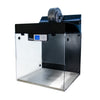Laminar Flow Hoods: ISO Classification
The cleanliness of air within a laminar flow hood is typically stated in terms of its classification according to ISO Standards.
ISO Classification
The classification of a laminar flow hood is established by the International Organisation for Standards Cleanrooms and Associated Controlled Environments (ISO-14644-1:2015). However, sometimes cleanliness values are given via the superseded Federal Standards for Airborne Particulate Cleanliness Classes in Cleanrooms and Clean Zones (FED-STD-209E).
In these standards, cleanliness is determined by measuring the total number of particles within a sample of air. To do this, particles are grouped into classes of different sizes. The number of particles within each group must be less than the values given within the standards for the particular class.
This table shows the different ISO cleanroom classifications for air cleanliness. The particle counts are given in particles per cubic metre and include particles of the same size or larger.
| ISO Class Number (N) | ≥0.1 µm | ≥0.2 µm | ≥0.3 µm | ≥0.5 µm | ≥1 µm | ≥5 µm | FED-STD Class |
|---|---|---|---|---|---|---|---|
| 1 | 10 | ||||||
| 2 | 100 | 24 | 10 | ||||
| 3 | 1,000 | 237 | 102 | 35 | 8 | 1 | |
| 4 | 10,000 | 2,370 | 1,020 | 352 | 83 | 10 | |
| 5 | 100,000 | 23,700 | 10,200 | 3,520 | 832 | 100 | |
| 6 | 1,000,000 | 237,000 | 102,000 | 35,200 | 8,320 | 293 | 1,000 |
| 7 | 352,000 | 83,200 | 2,930 | 10,000 | |||
| 8 | 3,520,000 | 832,000 | 29,300 | 100,000 | |||
| 9 | 35,200,000 | 8,320,000 | 293,000 |
Clean room classifications range from Class 9 (the "dirtiest"), to Class 1 (the "cleanest"). For example, in an ISO Class 1 clean environment, there should be less than 10 particles per cubic metre in the space that are above 0.1 µm. A Class 5 environment must contain the following:
- Less than 100,000 particles /m2 that are larger than 0.1 µm
- Less than 23,700 particles /m2 that are larger than 0.2 µm
- Less than 10,200 particles /m2 that are larger than 0.3 µm
- Less than 3250 particles /m2 that are larger than 0.5 µm
- Less than 832 particles /m2 that are larger than 1 µm
- Less than 30 particles /m2 that are larger than 5 µm
ISO 5 Classification
ISO Class 5 (or FED Class 100) is the standard met by the highest quality clean room environments. This environment is suitable or semiconductor research, research and development clean rooms, and medical laboratory research.
The Ossila laminar flow hood is rated ISO Class 5 when used with a HEPA filter. With the same particle sensing technology used to measure clean room cleanliness, the system is able to monitor the air coming out of the hood. Using this information, the system provides a real time air cleanliness value, so you always know exactly how clean the air you are working in is.
Laminar Flow Hoods

- Vertical/Horizontal Models
- Fully Equipped
- High Purity Air
Available Now! £2,500
Contributing Authors
Written by
Product Developer
Edited by
Application Scientist